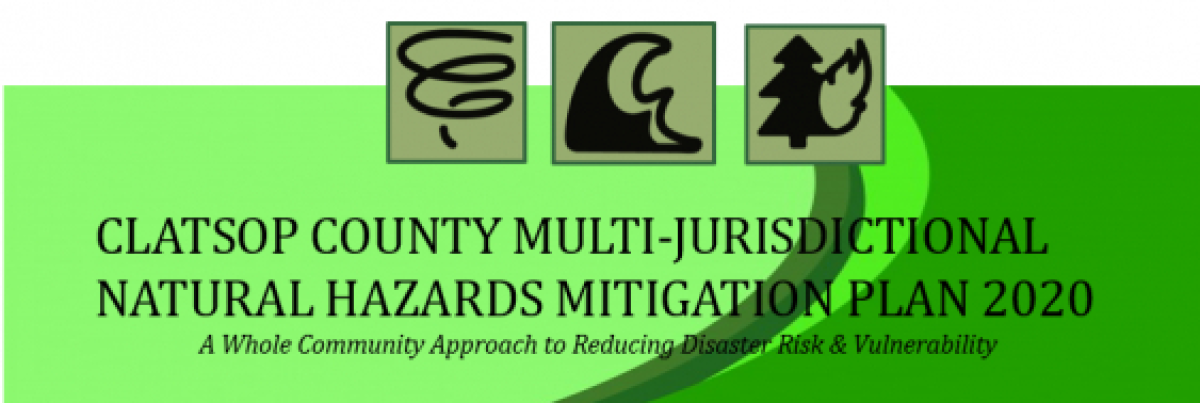
Hazard mitigation describes actions taken to help reduce or eliminate long-term risks caused by hazards or disasters, such as flooding, earthquakes, wildfires, landslides, or dam failure. As the costs of disasters continue to rise, governments and citizens must find ways to reduce hazard risks to our communities.
In 2018, Clatsop County received FEMA grant assistance through the Department of Land Conservation and Development (DLCD) to prepare a Multi-Jurisdictional Natural Hazard Mitigation Plan (MJNHMP), and in 2021, along with all 5 cities and 10 special districts, Clatsop County completed the MJNHMP.
The MJNHMP presents a strategy for reducing our communities' vulnerability to the impacts of natural hazard events such as earthquakes, flood, and wildfire. We've created this page to educate the community while providing information and resources to those who may have interest in the planning process. Whether interested in participating in the process or simply getting information about how to guard against natural hazards, we encourage you to explore this page and the links provided to gain familiarity with the world of hazard mitigation in Clatsop County.
What is the Hazard Mitigation Plan? The Hazard Mitigation Plan is a framework that guides our community in making decisions and developing policies to reduce or eliminate risk to life and property. The plan identifies the types of hazards that threaten our community, evaluates our vulnerability to those threats, and outlines a strategy to reduce or eliminate the risk posed by those threats to break the cycle of repeated destruction by natural hazard events.
Who participates in the Hazard Mitigation Plan? Hazard mitigation planning is the process used by state, local and tribal leaders to understand risks from natural hazards and develop long-term strategies to reduce the impacts of disasters on people, property, and the environment. In 2015, the Clatsop County and the cities of Astoria, Cannon Beach, Gearhart, Seaside, and Warrenton completed plans for their respective jurisdictions. Since that time, the importance of mitigation planning as it relates to a community's resilience has become a central theme in emergency management; the planholder group for the 2020 Clatsop County MJNHMP includes the former participants as well as 10 new special service districts:
- Clatsop County
- City of Astoria
- City of Cannon Beach
- City of Gearhart
- City of Seaside
- City of Warrenton
- Port of Astoria
- Sunset Empire Transportation District
- Clatsop Community College
- Seaside School District
- Cannon Beach Rural Fire Protection District
- Lewis & Clark Fire Department
- Knappa-Svensen-Burnside Fire
- Arch Cape Water District
- Arch Cape Sanitary District
- Falcon Cove Beach Domestic Water Supply
Why is the plan important? The Federal Disaster Mitigation Act of 2000 (DMA 2000) requires that a community have an approved hazard mitigation plan in order to be eligible to apply for and receive FEMA hazard mitigation funds. Receipt of these funds can be critical to implementation of identified hazard mitigation programs.
What information is in the Hazard Mitigation Plan? The MJNHMP assesses the community’s risks and vulnerabilities to natural hazard events such as earthquakes, flooding, and wildfire. The MJNHMP includes a set of goals related to the overall goal of hazard mitigation planning and mitigation measures that will serve to advance the plan goals.
Meeting Information
Agenda:
MJNHMP Meeting Agenda - 05/12/23
MJNHMP Meeting Agenda - 12/06/21
Minutes:
MJNHMP Meeting Minutes - 05/12/23
Web Links
- Tsunami Land Use Planning Guide
- Natural Hazards Mitigation Planning
- Tsunami Planning
- Coastal Data, Tools & Publications
- State of Oregon NHMP
- Statewide Hazard/Risk Assessment
- Goal 7: Oregon Land Use Goals/Guidelines
- National Flood Insurance Program in Oregon
- DLCD Hazard News Listserv
- FEMA Listserv Groups




